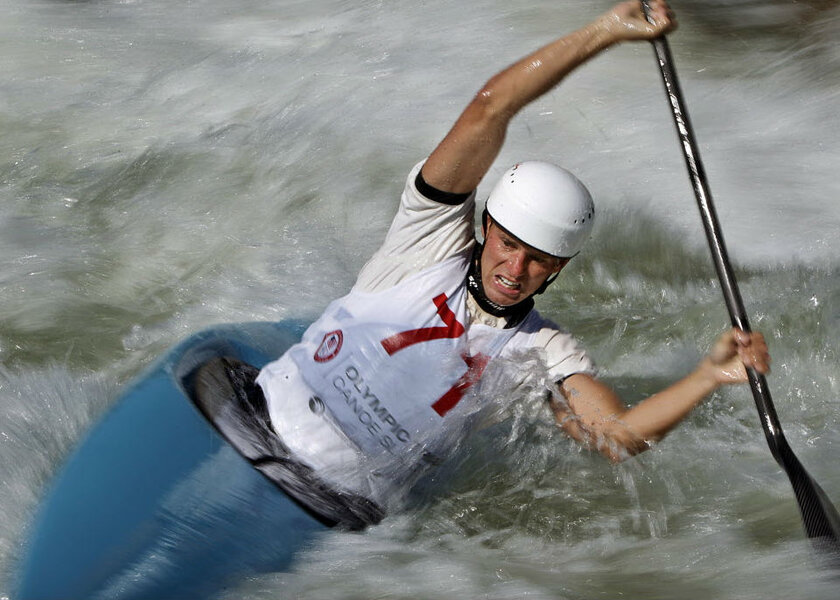Kayaking as learning: Navigating life's knowledge whitewater
Loading...
Play is essential, says John Seely Brown, to becoming the kind of learner that keeps up with the ever-moving flow of activity, interaction, and knowledge of today’s networked world – learning that needs to be more like whitewater kayaking than a steamship that has a set course and just keeps moving along it for a long time.
In a kayak, said Mr. Seely Brown, author, senior fellow at the University of Southern California’s Annenberg Center for Communication, and former chief scientist at Xerox PARC. “You have to be in the flow, pick things up on the moment, feel it with your body, be a part of the flow – in it, not just above it and learning about it. In this new world of flows, knowledge is an action sport. How do we participate in these flows?” he asked in his keynote talk at the 2012 Digital Media & Learning conference in San Francisco in March.
Our kids can demonstrate
It might help us to watch our children do just that. Watch them participate in the unpredictable, constantly changing flow of play in multiplayer games and virtual worlds online and in gaming communities such as Xbox Live (Pew says 97% of US 12-to-17-year-olds play games; do they know something we’re only just beginning to figure out?). Video games are simulations of the world that Seely Brown is describing.
Today’s digital infrastructure is “radically different from anything civilization has ever seen before,” he said. In the past, we’d have “brief moments of radical disruption,” then 40 to 60 years of stability [e.g., "electrification hasn't changed one iota in the past 100 years," he said] during which we developed the institutional and social forms and practices that knew how to use those infrastructures.
In the 21st century, there’s “no stability in sight,” with change “driven by continual exponential advances in computation…. It’s not about learning the old so much as creating the new.” We’re now, at the societal level, having to figure things out as we go, learning and picking up skills on the fly while immersed in the problem. “We can now expect the 1/2 life of a skill – most skills we pick up – to have about five years,” Seely Brown said, whereas in the past “we could pick up a set of skills and basically hold those for life.” Now we’re constantly reinventing, augmenting those skills.
Not knowledge transferred & stored
So it seems to me, he’s talking about something our children are quite skilled at, though the skills are not typically being acquired in school. He’s pointing to a significant disconnect between that immersive learning-as-they-go in games and the learning at school, which is still preparing steamships for the future rather than whitewater kayaks. School is based on the knowledge-transfer model – “you pick up a set of fixed [knowledge] assets that are authoritative and transferred to you in the delivery mechanisms of schooling, which has wonderful scalable efficiency” for delivering the assets to 30, 100, or a million people simultaneously.
That worked when we/the world had those 40-to-60-year periods of stability, when knowledge and authority had time to become “final” and be transferred to the future adult generation’s repositories of authority: experts. Knowledge that’s stored is inaccessible, Seely Brown seems to be saying; knowledge that’s shared is useable.
But what type of knowledge are we working with? Tacit knowledge, he said. “In a world of constant flux, learning has as much to do with creating the new as learning the old – but in creating the new, much of what is created is basically tacit, hasn’t had enough time to be crystallized out as explicit knowledge” – the explicit knowledge that was transferred from our teachers to us when we were in school.
So how can school – and if not school, then parents – help our children “cope with the tacit knowledge that kind of flows hidden beneath us all the time,” as this author, scientist, and educator put it?
Know. Make. Play
Back to that point about play. Besides the discussion about school, my takeaway from Seely Brown’s talk is that we very much need to clear space for our children to play – with digital media, solid objects (I’m thinking of the film Hugo), whatever they love to play with, and make sure some of that is the collaborative or social play that many children love too. He said that, especially now, we need to be all three: homo sapiens (man as knower), homo faber (man as maker, or “tinkerer”), and homo ludens (man as player).
Psychiatrist Stuart Brown said play is “a process of nature that’s within all of us” and essential to mental health and social efficacy. In that process of play, the player figures out how to…
- Work with and create constantly flowing tacit knowledge
- Turn it into the solution needed in the moment
- Respond to a new set of conditions with the experience just gained and new tacit knowledge flowing in from fellow players and other sources, and
- Repeat and
- Repeat….
It’s a dynamic process for our dynamic, shrinking, networked world, where answers, solutions, and “meaning emerge as much from context as from content,” Seely Brown said – the context that’s like whitewater, the flow of a classroom, a multiplayer video game, an improvisational theater stage, a group videochat, protests online and on streets, etc. So is it possible that the 97% of US 12-to-17-year-olds who play video games know something intuitively that we’re only just beginning to figure out? Might we consider what their process has to teach us?
The Christian Science Monitor has assembled a diverse group of the best family and parenting bloggers out there. Our contributing and guest bloggers are not employed or directed by the Monitor, and the views expressed are the bloggers' own, as is responsibility for the content of their blogs. Anne Collier blogs at NetFamilyNews.






